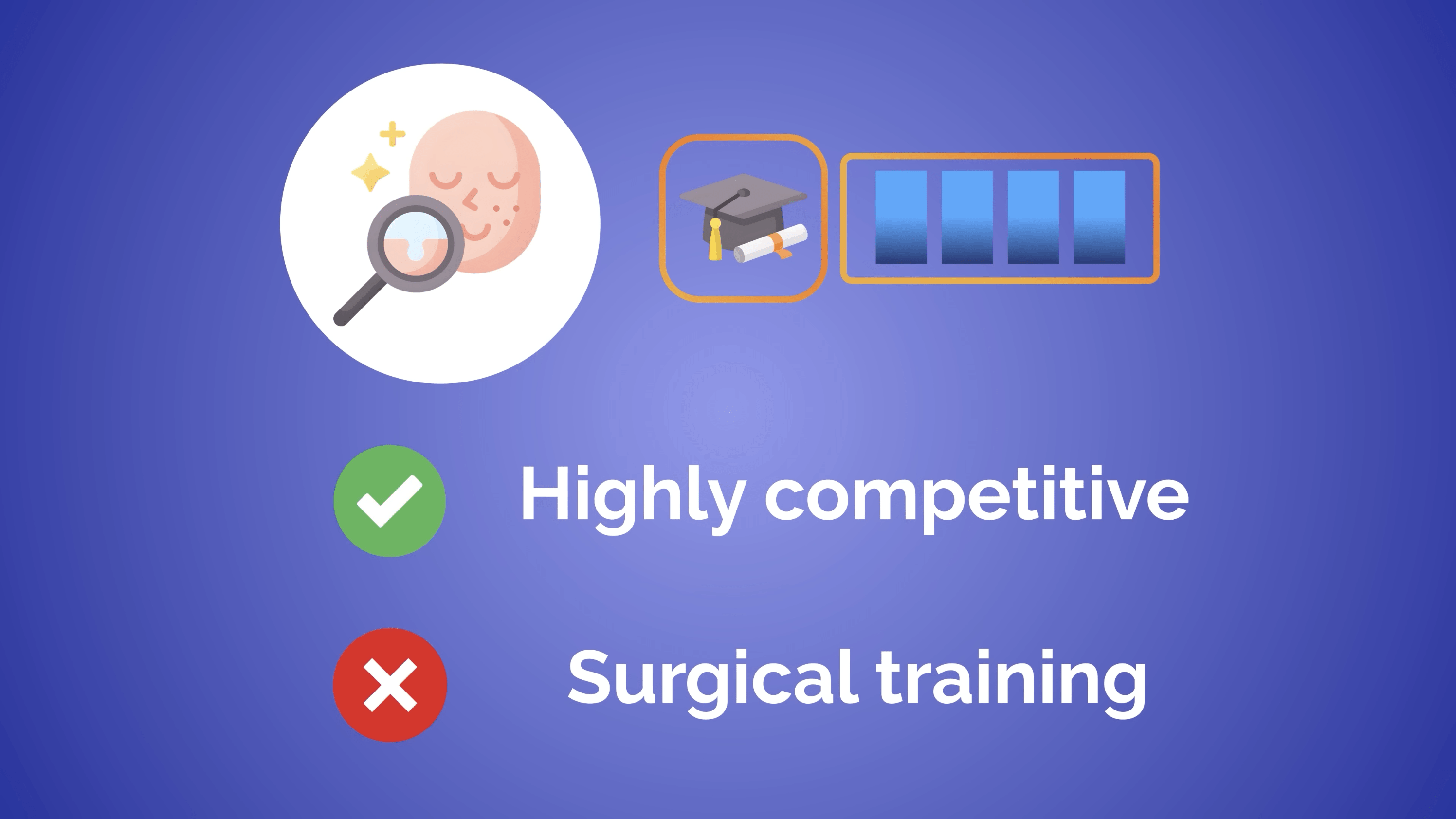Plastic surgeon vs cosmetic surgeon—Welcome to our Career Battles series, where we compare two different medical career options to help you decide which is the best path for you. We’ll break down training requirements, compensation, lifestyle, and the pros and cons of pursuing each career path.
In our previous guides, we covered doctor vs surgeon, diagnostic vs interventional radiologist, and neurologist vs psychiatrist. Next up in the battle arena is plastic surgeon vs cosmetic surgeon.
Overview: Plastic Surgeon vs Cosmetic Surgeon
First, let’s clarify a common misconception: plastic surgeons and cosmetic surgeons are quite different, although the terminology makes things confusing.
You can generally use aesthetic or cosmetic surgery interchangeably; however, a cosmetic surgeon is not the same as a plastic surgeon.
People often confuse these two because cosmetic surgeons perform similar procedures to aesthetic plastic surgeons. The difference is in the training. And far too often, cosmetic surgeons are seen in the same light as plastic surgeons despite a significant difference in training.
Both plastic surgeons and cosmetic surgeons provide various cosmetic procedures, both surgical and non-surgical. However, plastic surgeons complete 6-8 years of focused surgical training.
And this training is recognized by the ABMS, the American Board of Medical Specialties, and the ACGME as well. Cosmetic surgeon, on the other hand, is a loosely defined term that’s certified by the ABCS, the American Board of Cosmetic Surgery, which is not recognized by the ACGME or the ABMS. Not being recognized by these accrediting bodies means the standards and training both vary widely and are not rigorous.
When people unfamiliar with medicine think of plastic surgery and cosmetic surgery, they think of aesthetics, but plastic surgery is focused on both aesthetics and reconstructive surgery, and the principles that allow you to become a great cosmetic surgeon are very similar to those of reconstructive surgery.
And far too often, cosmetic surgeons are misleading or outright dishonest about their training. They are completely fine with being seen by the public as equal to plastic surgeons.
Many of the plastic surgery friends and colleagues I trained with, who are now attendings in Southern California, are oftentimes fixing horrific complications after cosmetic surgeons, without adequate training, butcher their patients.
Let’s dig a little deeper into training differences.
Plastic Surgeon vs Cosmetic Surgeon Training
The training paths for these two careers differ dramatically.
To understand the training paths, you must start by understanding why cosmetic surgeons exist in the first place. Plastic surgeons can perform the aesthetic procedures performed by cosmetic surgeons, so why are there two different paths?
As with many things, if you follow the money, you’ll find the answer. Aesthetics is a booming and lucrative field—one that many people want to get in on. Cosmetic surgery training paths predominantly exist so that other types of physicians can get a piece of the action. It’s fundamentally driven by greed and the American public’s need for a quick fix, especially when it comes to their appearance.
To become a board-certified plastic surgeon, you must complete medical school, which is at least 4 years, followed by extensive residency training.
There are two residency paths:

The Integrated Path, which is 6 years of plastic surgery residency after medical school, or the Independent Path, which is 5 years of general surgery residency, then 3 years of plastic surgery residency.
And not only that, plastic surgery is consistently ranked as one of the most competitive specialties to match into, only recently falling behind dermatology and neurosurgery.
For a complete breakdown of specialty competitiveness across 22 doctor specialties, download our free Specialty Competitiveness Index.
After residency, plastic surgeons can further subspecialize with 1 to 2-year fellowships in areas like:
- Breast reconstruction surgery
- Craniofacial surgery
- Microsurgery
- Hand surgery
- Burn surgery
- Aesthetic surgery
On the other hand, the requirements to call yourself a cosmetic surgeon are minimal, the training is far less structured, and it’s not recognized as a real specialty of medicine. A cosmetic surgeon is a physician; however, they could be trained in any specialty, usually a nonsurgical field like family medicine, emergency medicine, or dermatology.
In many cases, additional training may only include weekend courses or short training programs in specific cosmetic procedures like Botox injections, liposuction, or even surgical procedures like breast augmentation.
This lack of rigorous and standardized training is the critical distinction between the two career paths.
Dermatology, for example, is currently the most competitive specialty and comes with a 4-year residency. Although competitive, a dermatologist doesn’t train in surgical procedures past medical school apart from a very small amount of Mohs skin cancer surgery in residency if they’re lucky, which is generally reserved for a Mohs fellowship. A 1-weekend course on a specific cosmetic procedure or even a 1 year cosmetic surgery fellowship doesn’t nearly compare to 6 to 8 years of dedicated surgical training.

But remember—any physician can add on minimal cosmetic surgery training and then market themselves as a cosmetic surgeon.
Family medicine is consistently the least competitive specialty with the shortest residency training at 3 years. The competitiveness and training gap between family medicine and plastic surgery is massive. This isn’t to say that family medicine doctors aren’t as good or aren’t trained enough. It’s that they are trained for what’s required of them in family medicine. Tacking on a cosmetic surgery course or even 1-year fellowship doesn’t make them qualified for aesthetic procedures.
In the best cases, with the most rigorous residency and closest possible overlap in subject matter, a cosmetic surgeon will complete a surgical residency first, something like general surgery or oral surgery, followed by a 1-year cosmetic surgery fellowship via the American Academy of Cosmetic Surgery.
Even in this best-case scenario, training in one type of surgery is not the same as plastic surgery training. Would you want an oral surgeon operating on your foot, or a plastic surgeon operating on your heart? Other types of surgeons don’t perform surgery directly related to aesthetic procedures until they take a cosmetics course or a 1-year fellowship, which isn’t nearly enough time to master these skills.
But, on the other hand, a plastic surgeon has been honing their soft tissue and wound healing skills for at least 6 years of residency. Even when not focusing on aesthetics, the skills taught in reconstructive surgery are directly connected and invaluable to aesthetic procedures.
Plastic Surgeon vs Cosmetic Surgeon Compensation
When it comes to compensation, both careers can be lucrative, but they vary significantly based on practice type, location, and training.
Board-certified plastic surgeons can earn over $600,000 annually, but this number includes surgeons who focus on reconstructive procedures, which isn’t nearly as lucrative as aesthetic surgery. Those who focus on reconstructive procedures, particularly in academic settings, typically earn less but still command salaries well above the average physician, which is $355,000.
Plastic surgeons with successful aesthetic practices can easily clear over a million dollars a year.
The incomes of cosmetic surgeons vary widely due to the lack of structure and the original specialty of the physician, which can range from family medicine to ENT to OB/GYN and anything in between.
Some cosmetic surgeons in major metropolitan areas with high-end practices and the marketing skills to match can earn comparable or even higher incomes than traditional plastic surgeons.
Plastic Surgeon vs Cosmetic Surgeon Lifestyle
How do plastic and cosmetic surgery compare in terms of lifestyle?
Plastic surgeons have demanding schedules during their 6 to 8 years of residency training. But once in practice, surgeons focusing on aesthetic procedures often have more predictable hours, as most surgeries are elective.
However, plastic surgeons who handle reconstructive cases or work with trauma centers may have longer surgeries, less predictable schedules, and more emergency call.
Cosmetic surgeons have a similar lifestyle to aesthetic plastic surgeons. However, a cosmetic surgeon’s lifestyle may also be dependent on the specialty they originally trained in, if they opt for a hybrid model, or are only completing cosmetic procedures on the side.
For example, the lifestyle of an emergency medicine doctor is intense and chaotic, putting these physicians at risk of burnout. On the other hand, dermatology is known for its relaxed work-life balance.
Pros and Cons of Becoming a Plastic Surgeon
What are the pros and cons of becoming a plastic surgeon?
Let’s start with the pros.
One of the greatest advantages of becoming a plastic surgeon is the comprehensive training that allows you to perform both reconstructive and cosmetic procedures. The diversity and variety you’ll experience in plastic surgery are second to none, and it’s arguably one of the most innovative fields in medicine, with procedures that seem straight out of science fiction.
Plastic surgeons have the unique ability to transform patients’ lives through reconstruction after trauma, cancer, or congenital issues. Plus, plastic surgeons have the option to transition to a cash-based aesthetic practice, which provides immunity to potential decreases in insurance reimbursements.
However, this path isn’t without its challenges.
Plastic surgery is a hyper-competitive tier 1 specialty, requiring stellar academic performance, a massive research requirement, and the clinical skills to match. The training pathway is lengthy, requiring a minimum of 6 to 8 years of residency after medical school. It’s also a specialty that demands precision and meticulousness—it’s not for those who dislike obsessive attention to detail.
The pay can also vary more than in other specialties, especially for those who focus on reconstructive practices rather than aesthetic work.
Pros and Cons of Becoming a Cosmetic Surgeon
Now, what are the pros and cons of becoming a cosmetic surgeon?
Most cosmetic surgeons enjoy flexible practice models and the ability to add cosmetic procedures to an existing practice. For physicians already established in another specialty, the cosmetic surgery path is a much shorter training pathway—there’s no doubt about that.
In the right location and with strategic, but often tricky marketing, cosmetic surgeons have the potential to rake in the same seven-figure salary, without spending years training.
But this lack of adequate training can result in significant consequences for physicians and their patients. Without comprehensive plastic surgery training, you won’t have the foundational skills that board-certified plastic surgeons do. There’s a higher risk of complications and suboptimal outcomes, which can harm the patient and expose you to malpractice claims.
Which Path Is Best for You
So, which career path is best for you?
If you can handle the rigorous training and have the scores and technical skills to match, becoming a board-certified plastic surgeon is the gold standard. This path offers comprehensive training, respect among colleagues and patients, and the widest range of practice options.
Unfortunately, not everyone is cut out for this path. Plastic surgery is one of the most competitive specialties. It’s one of the longest residency programs, and it requires a level of precision and attention to detail that few possess.
But not having the time or not being cut out for plastic surgery isn’t a reason to take shortcuts on your training.
What medical career paths would you like us to cover next? Psychologist vs psychiatrist, doctor vs nurse practitioner, or EM doctor vs trauma surgeon? Let us know in the comments.








